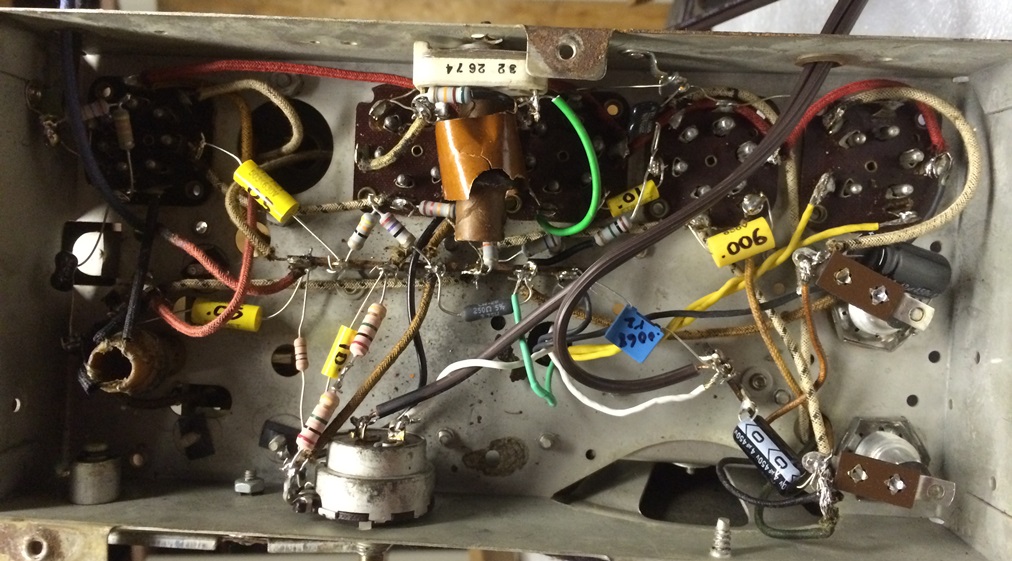Posts: 15
Threads: 7
Joined: Mar 2015
City: Roanoke, VA
Hi,
Is the tuning condenser of the 39-6C supposed
to be isolated with rubber grommets from the
radio chassis?
Thanks.
Tom2
Posts: 5,006
Threads: 267
Joined: Nov 2012
City: Bandon
State, Province, Country: OR
Moving this to Electronic Restoration section...
Posts: 15,307
Threads: 532
Joined: Oct 2011
City: Jackson, NJ
Tom
I have the chassis at home, will look tonite, but meantime:
According to the sch one of its terminals is grounded. Trace the wire that goes from 6A7 grid cap to the tuning cap. This is the terminal that is insulated from the chassis. Whatever part of cap (rotor or stator) it goes to, the OTHER one is supposed to be grounded to the chassis.
People who do not drink, do not smoke, do not eat red meat will one day feel really stupid lying there and dying from nothing.
Posts: 126
Threads: 13
Joined: Sep 2013
City: Milwaukee, Wisconsin
I have a 39-6 sitting out of its cabinet right now. I don't see any rubber mounts. It appears to be rigidly mounted to the chassis. There are some kind of metal C shaped things between the condenser and chassis.
Posts: 7,212
Threads: 266
Joined: Dec 2009
City: Roslyn Pa
On some set ( not this one) the tuning condenser is floating above ground so the mixer and or the RF amp can be connected to the AVC/AGC buss.
Terry
Posts: 15,307
Threads: 532
Joined: Oct 2011
City: Jackson, NJ
On some sets the rotor is grounded and not stator. Like 70 or 90.
But you can only bolt the stator to the chassis. So if rotor is grounded the stator is grommeted.
This is as I understand used to counter the fact that if the stator is grounded by not using grommets, then when you tune you create extra capacitance between the rotor and the chassis through the body so tuning become less precise. If the rotor (shaft) is grounded then you can touch the shaft and no tuning problem will occur.
People who do not drink, do not smoke, do not eat red meat will one day feel really stupid lying there and dying from nothing.
Posts: 7,212
Threads: 266
Joined: Dec 2009
City: Roslyn Pa
Have had some sets that the rotor shaft has a large piece of copper braid soldered to it and the other end grounded. To be sure that it it had a good gnd connection.
Terry
Posts: 15,307
Threads: 532
Joined: Oct 2011
City: Jackson, NJ
Usually those are leaf spring contacts. Sometimes the case is in fact the rotor as the stator is inside tbe case insulated with fiber washers, and the rotor shaft is connected to the case via bearings and springs, which case is in turn bolted to the chassis (Philco 20).
People who do not drink, do not smoke, do not eat red meat will one day feel really stupid lying there and dying from nothing.
Posts: 15
Threads: 7
Joined: Mar 2015
City: Roanoke, VA
Hi,
First off let me say thank you to the folks who
replied to my question. What I have holding the
tuner to the chassis are those spring clips.
Morzh - there is a insulated wire going from the top of the
tuning condenser to point 3 on the antenna transformer, also
there is a wire going from the top of the tuning condenser to
the grid cap of 6A7. From the bottom of the tuning condenser
there is a green insulated wire going to point 1 of the Oscillator
Transformer. Is this right?
Nick3092 - would it be possible for you to post a picture of the
bottom of your 39-6 radio chassis, so I can compare?
Again thanks to all for the help. Stay tuned for more questions.
Tom2
Posts: 15,307
Threads: 532
Joined: Oct 2011
City: Jackson, NJ
The stator is grounded. It has protrusions with thread and they bolt with nuts on the other side to the chassis.
People who do not drink, do not smoke, do not eat red meat will one day feel really stupid lying there and dying from nothing.
Posts: 126
Threads: 13
Joined: Sep 2013
City: Milwaukee, Wisconsin
Here you go. I can email you a slightly higher resolution one if you want.

This was a pretty easy chassis to work on. Not cramped, and not too many parts. A few things on my refurbs you may wonder about.
I always parallel/series resistors to exactly hit odd ball values. I know most modern stock values will work fine. I'm just anal that way.
I always overrate my CT bias resistors. Which is why I have a 3.75W and 2W resistors in place of the 1/2W rated ones. These resistors usually have a fair amout of current through them. But that varies by radio design. Again, just an anal thing.
I replace all resistors, even those in spec. Usually 25-50% are already drifted high. And its a matter of time before the rest drift high. I only want to refurb a chassis once, so they all get replaced.
I pretty much always replace micas. This is personal choice and hotly debated. My stance is that too many people have started to see them fail, and again - I only want to refurb a chassis once.
I often use a 1 lug terminal strip to attach the "foot" to the old lytic cans. The top lug is not connected, so it gives you a nice handy tie point pretty close to the original.
Posts: 15
Threads: 7
Joined: Mar 2015
City: Roanoke, VA
Nick,
Thanks so much for the picture.
That's a great help. It looks like
we do some of the same things
when we restore these radios.
Tom (Tom72)



